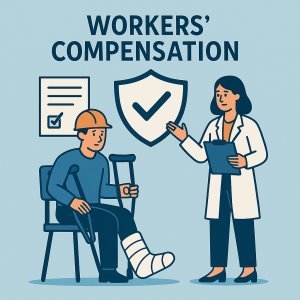
Armed Guard Workers’ Comp Rate Benchmarks in Georgia for 2024
July 27, 2025
Security Guard Workers’ Comp vs. Disability Insurance: Complement or Overlap?
July 28, 2025In today’s unpredictable business environment, organizations face a wide array of risks that can lead to workplace injuries and subsequent workers’ compensation claims. Effective crisis management plans are essential tools for minimizing the financial and operational fallout associated with such incidents. By proactively addressing potential hazards, streamlining response protocols, and fostering a culture of safety, companies can not only reduce the frequency and severity of claims but also safeguard employee well-being and organizational reputation. This article explores the critical components of crisis management plans designed to mitigate workers’ compensation impacts, offering actionable insights for business leaders committed to resilience and risk reduction.
Table of Contents
- Crisis Preparedness Strategies for Reducing Workers compensation Claims
- Effective communication Protocols During Workplace Emergencies
- Implementing Safety Training to Mitigate Injury Risks
- Post-Incident Review and Policy Adjustment for Continuous Improvement
- Q&A
- To Wrap It Up
Crisis Preparedness Strategies for Reducing Workers Compensation Claims
Implementing proactive measures is key to mitigating the risks that lead to workers’ compensation claims during crises. Businesses should prioritize thorough risk assessments that identify potential hazards specific to both the crisis at hand and the unique operational environment. This includes regular safety drills and updated emergency response protocols that emphasize clear communication and quick decision-making. moreover, investing in employee training programs focused on crisis awareness and safety compliance empowers teams to act responsibly and minimizes workplace injuries.
Another crucial component involves creating a robust incident documentation and support system. Employers who establish streamlined reporting channels and provide immediate access to medical assistance not only improve outcomes for affected workers but also expedite claim processing. Below is a comparison of key strategic elements to focus on during crisis preparedness:
| strategy | benefit | Implementation Tip |
|---|---|---|
| Risk Assessments | Identifies hazards early | Conduct quarterly reviews |
| Employee Training | Enhances readiness | Use scenario-based learning |
| Clear Communication | Reduces confusion during crises | Implement multi-channel alerts |
| Incident Reporting | Speeds claim processing | Utilize digital reporting tools |
| Immediate Medical Support | Lessens injury severity | Set up onsite first aid stations |
Effective Communication Protocols During Workplace Emergencies
Clear and timely communication is paramount when dealing with workplace emergencies. Establishing predefined channels and protocols ensures that data flows efficiently to all relevant parties, reducing confusion and enabling swift action.Utilize a combination of digital tools-such as emergency notification systems, SMS alerts, and dedicated communication apps-to guarantee messages reach employees regardless of their location. Additionally,assign roles to specific team members for disseminating information and managing response coordination,which fosters accountability and streamlines the emergency response process.
To enhance clarity during high-stress situations, standardize the messages with concise templates covering key points such as the nature of the emergency, expected employee actions, and safety updates. Below is a sample communication protocol matrix designed for rapid deployment, highlighting duty zones and communication mediums:
| Role | Responsibility | Communication Channel |
|---|---|---|
| Emergency Coordinator | Overall command and decision-making | phone, Radio, Email |
| Safety Officer | Risk assessment and hazard alerts | SMS, Walkie-Talkie |
| HR Manager | Personnel updates and worker support | Email, Company Intranet |
| All Employees | Follow instructions and report incidents | Mobile Alerts, PA System |
- Maintain regular drills to test and refine communication protocols.
- Encourage feedback post-emergency to identify breakdowns and areas for improvement.
- Ensure multilingual capabilities if your workforce is diverse, to eliminate language barriers.
implementing Safety Training to mitigate Injury Risks
Establishing a comprehensive safety training program is paramount to reducing the incidence of workplace injuries, thereby limiting the financial and operational impact of workers’ compensation claims. effective training not only educates employees on proper protocols but also fosters a culture of vigilance and responsibility. Incorporating hands-on demonstrations, regular refresher courses, and scenario-based drills ensures that safety knowledge is retained and applied consistently in day-to-day operations.Prioritizing employee involvement in identifying hazards can further enhance the program by tailoring solutions to real-world challenges.
Key components of a accomplished safety training initiative include:
- Detailed risk assessments to target specific operational vulnerabilities
- Clear communication of safety policies and incident reporting procedures
- Integration of technology, such as virtual reality simulations, to simulate high-risk scenarios
- Ongoing evaluation and feedback mechanisms to measure program effectiveness
| Training Element | Benefits | Frequency |
|---|---|---|
| Hazard Recognition | Proactive identification of risk factors | Quarterly |
| Emergency Response Drills | Improved reaction time during incidents | Biannually |
| Equipment Safety | Reduced machinery-related injuries | Monthly |
Post-Incident Review and Policy Adjustment for Continuous Improvement
Following the resolution of an incident, a thorough evaluation process is essential to identify underlying causes and organizational vulnerabilities.This involves gathering detailed reports from all stakeholders, reviewing incident timelines, and assessing the effectiveness of the immediate response. By extracting key insights,organizations can pinpoint procedural gaps and operational inefficiencies that contributed to the event,thus enabling decisive corrective action.
Key activities during this phase include:
- Analyzing injury reports and compensation claims to identify trends
- Soliciting feedback from impacted employees to gauge response adequacy
- Benchmarking outcomes against industry standards to align best practices
- Revising training protocols and safety measures based on findings
| Action | Purpose | Expected Outcome |
|---|---|---|
| Incident Debriefing | Collect qualitative data | Comprehensive understanding of event dynamics |
| Policy Revision | Address process inadequacies | Reduced risk of recurrence |
| Employee Retraining | Update safety competencies | Enhanced preparedness and compliance |
Q&A
Q&A: Crisis Management Plans – Minimizing Workers’ Compensation Fallout
Q1: What is the importance of a crisis management plan in relation to workers’ compensation?
A1: A crisis management plan is essential for proactively addressing workplace incidents that could lead to injuries. by having a structured response, businesses can minimize the severity and frequency of workers’ compensation claims, reduce downtime, and maintain operational stability. This planning helps ensure timely medical attention, proper documentation, and communication, which collectively mitigate financial and reputational impacts.
Q2: How does a crisis management plan reduce workers’ compensation costs?
A2: A well-crafted crisis management plan enables quick and effective response to workplace injuries, limiting their severity and preventing complications. It facilitates efficient claims processing, ensures compliance with regulations, and promotes return-to-work programs. These factors contribute to lowering claim durations, medical expenses, and insurance premiums, ultimately reducing overall workers’ compensation costs.Q3: What are the key components of an effective crisis management plan concerning workplace injuries?
A3: critical components include:
- Clear incident reporting procedures
- Immediate medical response protocols
- Employee training on safety and crisis response
- Designated crisis management team with defined roles
- Communication strategy with employees, insurers, and regulators
- Post-incident investigation and corrective action
- Return-to-work programs to support injured employees’ recovery
Q4: How can companies ensure employee participation in crisis management efforts?
A4: Employee participation can be fostered through ongoing training, transparent communication, and involving workers in safety committees or drills. Encouraging a culture of safety and accountability makes employees more likely to adhere to procedures and report incidents promptly. Recognition programs for proactive safety behaviors may also enhance engagement.
Q5: What role does communication play in minimizing workers’ compensation fallout during a crisis?
A5: Effective communication ensures that all stakeholders are informed and coordinated, reducing confusion and delays in response. Clear messaging helps manage employee concerns, satisfies regulatory requirements, and facilitates accurate claims documentation. transparent communication can also maintain trust and morale during challenging situations.
Q6: How frequently enough should crisis management plans be reviewed and updated?
A6: Crisis management plans should be reviewed at least annually and after any notable incident or organizational change. Regular updates ensure that procedures remain relevant, incorporate lessons learned, and adapt to evolving legal and industry standards.
Q7: Can implementing a crisis management plan improve a company’s insurance risk profile?
A7: Yes. Insurers frequently enough view companies with robust crisis management and safety protocols as lower risk, which can lead to reduced premiums and better coverage terms. demonstrating effective risk mitigation reassures insurers that the company is committed to preventing and managing workplace injuries efficiently.
Q8: What is the potential impact of neglecting crisis management planning on workers’ compensation outcomes?
A8: Without a crisis management plan, companies risk delayed responses, inadequate injury management, inconsistent reporting, and non-compliance with regulations. This can lead to increased claim costs, longer employee absences, regulatory penalties, and damage to the company’s reputation and employee morale.
This Q&A outlines critical insights for businesses seeking to minimize workers’ compensation fallout through strategic crisis management planning, emphasizing a proactive, organized approach to workplace safety and incident response.
To Wrap It up
In today’s volatile business environment, having a robust crisis management plan is not just a best practice-it is an essential component of safeguarding your organization’s operational integrity and financial stability. By proactively addressing potential workplace incidents through comprehensive strategies, companies can significantly minimize the adverse effects of workers’ compensation claims. Implementing clear protocols, fostering open communication, and continuously training your workforce empower your organization to respond effectively when crises arise. Ultimately, a well-crafted crisis management plan not only reduces the fallout from workers’ comp issues but also reinforces a culture of safety and resilience that benefits employees and the business alike.
“This content was generated with the assistance of artificial intelligence. While we strive for accuracy, AI-generated content may not always reflect the most current information or professional advice. Users are encouraged to independently verify critical information and, where appropriate, consult with qualified professionals, lawyers, state statutes and regulations & NCCI rules & manuals before making decisions based on this content.






